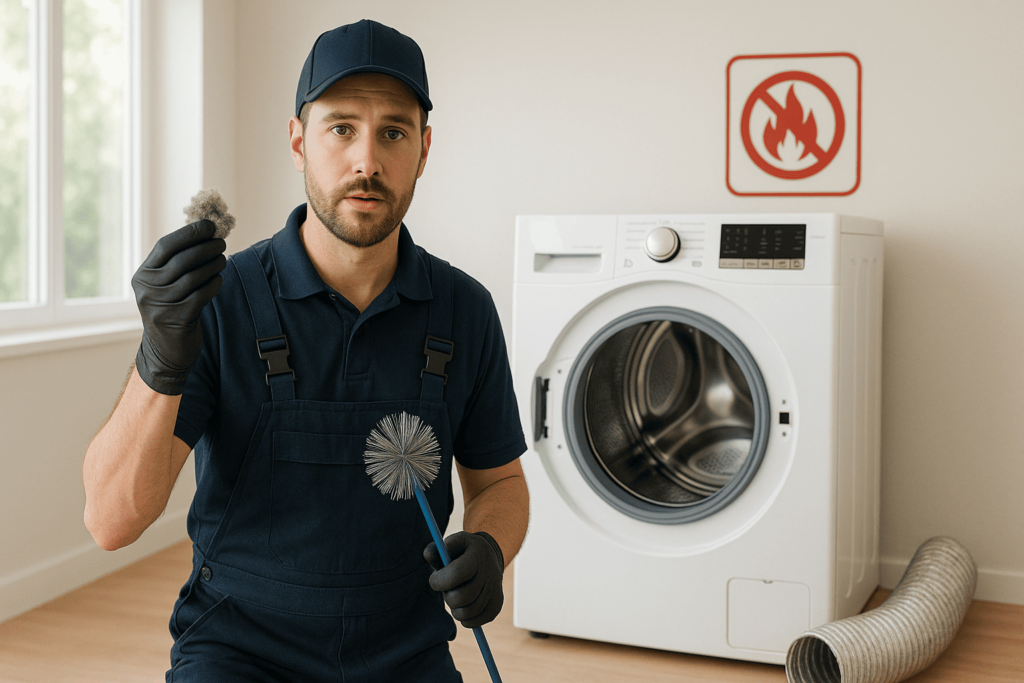
Dryer vent cleaning is one of the most effective steps you can take to prevent home fires in Southern California. According to the U.S. Fire Administration, clothes dryers cause nearly 2,900 home fires every year—most due to lint buildup in the vent system. Regular dryer vent cleaning not only keeps your appliance working efficiently but also protects your family and property from fire risk. In this guide, you’ll learn what causes dryer vent clogs, how to spot warning signs, the safest cleaning methods, and when it’s time to call a professional.
How a Dryer Vent Works and Why It Gets Clogged
A dryer vent moves hot, moist air and lint from your dryer to the outdoors. Over time, lint, dust, and even bird nests can block the vent. Even if you clean the lint trap after every load, some lint always escapes and sticks to the duct walls—especially if your vent is long, has many bends, or if you have pets. This gradual buildup narrows the vent, forcing your dryer to work harder and creating a serious fire hazard.
Fire Risks Associated with Clogged Dryer Vents
Lint is extremely flammable. When it accumulates inside the dryer vent, just a small spark or enough heat can ignite it. The National Fire Protection Association (NFPA) states that failure to clean the dryer is the leading cause of dryer fires. Besides the fire risk, blocked vents can cause carbon monoxide buildup in gas dryers and speed up appliance wear and tear.
Warning Signs That Your Dryer Vent Needs Cleaning
Watch for these red flags:
- Longer drying times: If it takes more than a cycle to dry clothes, airflow is probably blocked.
- Overheated clothes or appliance: Both should feel warm, not hot.
- Burning smell: Lint overheating can smell scorched.
- Lint visible around vent or outside flap: This means buildup is escaping.
- Dryer shuts off early: Safety sensors may trigger if airflow is poor.
If you notice these signs, stop using your dryer until you inspect and clean the vent.
Step-by-Step Dryer Vent Cleaning Tips
1. Unplug and Move the Dryer Safely
Always unplug the dryer. For gas models, shut off the gas valve. Carefully pull the dryer away from the wall for access.
2. Disconnect and Inspect the Vent Hose
Loosen the clamp and gently remove the vent hose from the dryer. Check for lint or debris inside.
3. Clean the Lint Trap and Filter
Remove the lint trap, clean it by hand or with a brush, and rinse it monthly to remove film. Do this after every load.
4. Use the Right Tools to Clean the Vent
Use a dryer vent brush kit, flexible rods, or a vacuum attachment to reach inside the vent duct. For very long vents, use a leaf blower or air compressor with caution.
5. Check and Clean the Exterior Vent
Go outside and clear any lint, debris, or nests from the vent cover. Make sure the flap opens freely.
6. Inspect and Clean Behind and Under the Dryer
Vacuum under and behind the dryer where dust and lint gather.
7. Reassemble, Reconnect, and Test the Dryer
Reconnect the hose, plug in the dryer, and push it gently back. Run a cycle and check that strong airflow exits outside.
Expert Tip:
If your vent is long, has many turns, or is hard to access, DIY kits may not reach all lint. This is when professional help is safest.
How Often Should You Clean Your Dryer Vent?
The NFPA recommends cleaning your dryer vent at least once a year. You may need to do it more often if you run frequent loads, have a long vent, own pets, or live in a humid area. If you notice any warning signs, clean immediately.
Professional Dryer Vent Cleaning: When and Why to Hire a Pro
DIY cleaning helps, but it’s easy to miss deep clogs—especially in vents that go through walls, ceilings, or attics. Appliance Repair Southern California uses specialized rotary brushes, vacuums, and airflow meters to remove all hidden lint, inspect the vent system, and check for damage or blockages. A professional cleaning takes about an hour and includes an airflow check and a safety guarantee.
What to expect from our service:
- Full vent and duct cleaning (inside and out)
- Lint and debris removal from all angles
- Inspection for damage, leaks, or unsafe vent materials
- Airflow testing to confirm safety
Customer Testimonial:
“We noticed the dryer was taking forever and smelled hot. Appliance Repair Southern California cleaned our vent and found a bird’s nest blocking the exit. Now our dryer runs fast and we feel safer at home!” – Jennifer L., Murrieta
Preventative Maintenance Tips for Dryer Fire Safety
- Clean the lint trap after every load
- Use rigid or semi-rigid metal vent pipes (avoid flexible plastic or foil)
- Keep the area around the dryer clear
- Schedule annual professional vent inspections
- Make sure your vent leads directly outside
Conclusion
Dryer vent cleaning is a simple but crucial step in protecting your home from fire. Lint buildup is a leading cause of dryer fires—but you can stay safe with routine cleaning, regular inspections, and professional help when needed.
Don’t risk a preventable fire. For certified, guaranteed dryer vent cleaning in Southern California, book your service today.
Frequently Asked Questions (FAQs)
How often should I clean my dryer vent for fire safety?
At least once a year, or more often with heavy use, pets, or long vents.
Can I use a regular vacuum to clean my dryer vent?
A vacuum helps with lint near the opening, but professional brushes are needed for deep cleaning.
What are the best tools for cleaning dryer vents?
Dryer vent brush kits, flexible rods, and professional rotary cleaning tools work best.
What is the risk if I never clean my dryer vent?
Fire risk rises, and your dryer becomes less efficient and can wear out faster.
How do I know if my dryer vent is a fire hazard?
Longer drying times, hot clothes, burning smells, or visible lint mean it’s time to clean.
Should I hire a professional dryer vent cleaning service?
Yes, for vents that are long, have multiple bends, or are hard to reach, and for a thorough safety check.
Can lint buildup cause carbon monoxide issues?
Yes, especially with gas dryers, blocked vents can lead to dangerous carbon monoxide buildup.
Is it safe to use flexible plastic or foil dryer vent hoses?
No, rigid or semi-rigid metal pipes are safest and recommended by fire authorities.
Does dryer vent cleaning lower my energy bills?
Yes, clean vents improve airflow and drying speed, which saves energy.
Where can I book a professional dryer vent cleaning in Southern California?
Book your dryer vent cleaning here with Appliance Repair Southern California.

Eric
Eric is the founder and lead repair expert at Appliance Repair Southern California. With 17+ years of experience, he has built a reputation for providing fast, reliable, and high-quality repair services across Southern California. His expertise covers a wide range of appliances, including refrigerators, ovens, dishwashers, and washing machines. Eric is committed to exceptional customer service and ensuring every repair is done right the first time. Under his leadership, Appliance Repair Southern California continues to be a trusted name in the industry.

